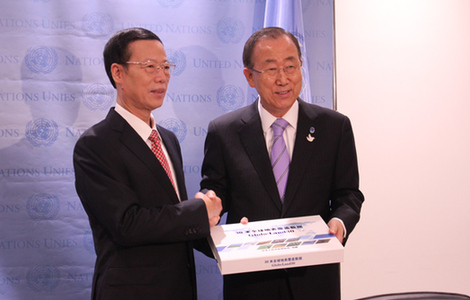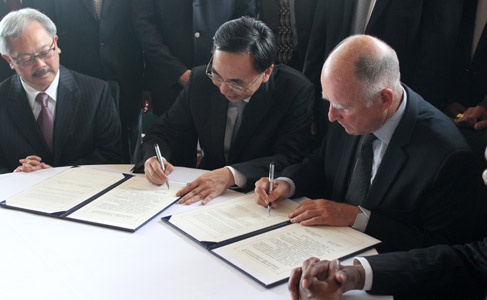Space-based technology to help deal with disasters
Updated: 2014-09-16 08:04
By Zhao Lei(China Daily)
|
||||||||
China will work more closely with other nations to better use its assets in outer space to manage disasters, a senior official said on Monday.
"Given the increasing impact of global climate change we will further promote the use of space-based technologies in disaster management," said Pang Chenmin, director of the National Disaster Reduction Center.
Peng was speaking at the three-day United Nations International Conference on Space-Based Technologies for Disaster Management, which opened in Beijing.
He urged the international space community to set up a system to give nations prone to disasters universal access to space-based technologies on disaster prevention.
The conference, the fourth to be held since 2011, is organized by the Ministry of Civil Affairs and the UN Office for Outer Space Affairs. It is being attended by government officials and experts from 34 nations, 14 international and regional organizations and 13 research institutes.
It aims to provide a platform for disaster management bodies and experts to strengthen their capabilities in using space-based information to identify, assess, monitor and respond to disaster risks and integrate space technology into long-term disaster risk management efforts.
This is according to a statement issued by the UN Platform for Space-Based Information for Disaster Management and Emergency Response, a program implemented by the UN outer space affairs office.
Luc St-Pierre, senior program officer with the office, said China has been supportive of the agency's work by offering financial help and allocating personnel to its Beijing office.
He said China is an active participant in the international space community and should take the lead in convincing the world that Earth observation instruments in space are essential to managing disaster risks.
The UN office is working with China to make more of its satellite images available to developing countries to help them improve disaster management, he said.
China signed the International Charter on Space and Major Disasters in May 2007 and first called for assistance under the charter in July of that year when devastating floods ravaged central and eastern areas of the country, according to the China National Space Administration.
To date, China has invoked the charter 17 times and obtained a significant amount of satellite data for post-disaster relief efforts, the administration said.
For its part, China offered satellite images to help handle forest fires in southeast Australia in 2009, floods ravaging Pakistan in 2010, and the earthquake and tsunami that hit Japan in 2011.
China has also assigned the high-resolution Earth observation satellite Gaofen 1 and weather satellite Fengyun 3C for duties under the charter and to replace their predecessor, the Shijian 9A, a technology demonstration satellite.
"The use of high-resolution satellites such as Gaofen 1 in disaster prevention and relief will become a major trend because they are able to observe a vast area of any given place on the Earth's surface and produce clearer pictures," said an industry insider close to China's geographic information authority who did not want to be identified.
zhaolei@chinadaily.com.cn
Most Viewed
Editor's Picks

|

|

|

|

|

|
Today's Top News
UN chief calls for intensified efforts on sustainable growth
Rice talks about relations between US, China
Xi stresses military headquarters' loyalty
Guideline helps battle against terrorism
Alibaba's IPO is only just the beginning: Ma
US group seeks 'no vacancy' for China's hotels
Rio expo gives China a showcase for its oil industry
Alibaba makes IPO history
US Weekly

|

|















